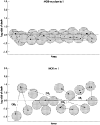A brief conceptual tutorial of multilevel analysis in social epidemiology: using measures of clustering in multilevel logistic regression to investigate contextual phenomena
- PMID: 16537344
- PMCID: PMC2566165
- DOI: 10.1136/jech.2004.029454
A brief conceptual tutorial of multilevel analysis in social epidemiology: using measures of clustering in multilevel logistic regression to investigate contextual phenomena
Abstract
Study objective: In social epidemiology, it is easy to compute and interpret measures of variation in multilevel linear regression, but technical difficulties exist in the case of logistic regression. The aim of this study was to present measures of variation appropriate for the logistic case in a didactic rather than a mathematical way.
Design and participants: Data were used from the health survey conducted in 2000 in the county of Scania, Sweden, that comprised 10 723 persons aged 18-80 years living in 60 areas. Conducting multilevel logistic regression different techniques were applied to investigate whether the individual propensity to consult private physicians was statistically dependent on the area of residence (that is, intraclass correlation (ICC), median odds ratio (MOR)), the 80% interval odds ratio (IOR-80), and the sorting out index).
Results: The MOR provided more interpretable information than the ICC on the relevance of the residential area for understanding the individual propensity of consulting private physicians. The MOR showed that the unexplained heterogeneity between areas was of greater relevance than the individual variables considered in the analysis (age, sex, and education) for understanding the individual propensity of visiting private physicians. Residing in a high education area increased the probability of visiting a private physician. However, the IOR showed that the unexplained variability between areas did not allow to clearly distinguishing low from high propensity areas with the area educational level. The sorting out index was equal to 82%.
Conclusion: Measures of variation in logistic regression should be promoted in social epidemiological and public health research as efficient means of quantifying the importance of the context of residence for understanding disparities in health and health related behaviour.
Conflict of interest statement
Competing interests: none declared.
References
-
- Boyle M H, Willms J D. Place effects for areas defined by administrative boundaries. Am J Epidemiol 1999149577–585. - PubMed
Publication types
MeSH terms
LinkOut - more resources
Full Text Sources




